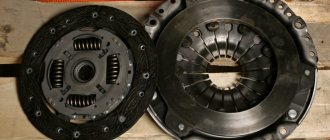Engine firmware
Modernization of the electronic control unit
Chip tuning Lada Vesta
The process of tuning performance modes by adjusting the control software is called chip tuning. Its main task is to increase the power of the vehicle’s power unit. Chip tuning Lada Vesta has approximately the same number of supporters and opponents.
Lada Vesta engine firmware - general information
Many car owners have heard about this process of setting up an internal combustion engine, having discovered the video on the Internet or learned about it from their own experience. The ability to quickly and at a low price upgrade the power unit by adding a certain amount of horsepower attracts people who want to squeeze every last drop out of the car.
Today, a considerable number of owners are engaged in this practice, who claim that the car has really improved in parameters. Reviews about chip tuning Lada Vesta vary dramatically, since there are enough disadvantages of the practice.
There are many examples of installing such chip tuning on engines of other large companies. Rumors say that the vehicle gains power from 5 to 25 hp. With. If you look towards the Russian market: despite the fact that the new product from AvtoVAZ has been on sale for about a year, there are a lot of requests for modernization of dynamic characteristics.
Engine firmware It’s worth knowing: a decent increase in power is only possible if the tuning process affects the main mechanical elements of the engine. Full-fledged chip tuning of the Lada Vesta internal combustion engine implies the mandatory replacement of the following parts:
- camshafts necessary to open and close the engine valve;
- piston - a part responsible for transforming gas or liquid into energy, and vice versa;
- intake system, which provides air supply for subsequent mixing with fuel;
- In addition, the process of new firmware of the electronic control unit of the power unit is mandatory.
Based on this, we can conclude that the price of such modifications can exceed 80 thousand rubles. Consequently, owners are limited to interfering only with the ECU of the engine model, without touching the internal elements of the system.
What kind of chip tuning are we talking about?
It is worth understanding that high-quality and large-scale chip tuning, which will provide a truly significant increase in power, is only possible with mandatory intervention in the design of Vesta engines. In this case, it means replacing the “hardware” - camshafts, pistons, intake and exhaust components, etc. Naturally, all this comes with new ECU firmware.
However, this option is not suitable for sedan owners, because the price will be simply excessive and, together with the cost of work, will easily exceed 50,000, or even 80,000 rubles.
For this reason, when it comes to chip tuning of Vesta, it means updating the firmware in the model’s ECU, without interfering with the mechanical part. But the decision in favor of such chip tuning is fraught with not only advantages. In addition to the advantages, there are also disadvantages. Therefore, it is also necessary to consider the risks and be prepared for the consequences.
Nuances of modernization
Modernization of the electronic control unit Most owners have a completely fair question: “If such an upgrade adds “tasty” capabilities to the dynamic characteristics of the car, why doesn’t AvtoVAZ do it?” Here restrictions on environmental standards come into force, which are becoming stricter from year to year. The tuned Lada Vesta will pollute the environment.
However, the degree of prohibitions on the territory of the Russian Federation is much lower than in the EU countries. A domestic plant cannot circumvent the law, therefore, when developing its power units, it tries to fit within the limits of restrictions and reduces the power of the car.
Without using chip tuning on a car, the owner of a Lada Vesta will not overpay when paying for transport taxation. Therefore, the manufacturer here takes care of the consumer. It should also be remembered that focusing on achieving maximum power is not a priority for automakers.
↑ Decrease in Vesta engine life
During surveys, many say that there are no changes in the resource, but no serious research has been conducted in this direction. The sampling was based on a survey of a couple of hundred cars. Therefore, we can conclude that the firmware does not affect the engine life.
However, if you conduct an experiment and compare a tuned engine with a regular one, the chip engine will wear out faster. Therefore, some studios still admit that a slight decrease in resource takes place. There is no point in focusing on this, since refueling with cheap gasoline affects the engine much more than reinstalling the firmware.
It should also be remembered that engine firmware negatively affects torque and gearbox. As a result, it will be necessary to change the settings of the AMT and electronic units, and this significantly complicates the procedure.
Chip tuning from Paulus
The Paulus company, well-known in the car upgrade market, offers its own version of the Lada Vesta upgrade. The main feature of this firmware, in addition to the main actions (changing the ignition angle, changing the fuel supply), is the ability to turn off the catalyst without consequences.
The upgrade gives a slight increase in dynamics and reduces gasoline consumption. The studio's specialists assure that all tests are professionally analyzed. To have your car flashed by specialists, you need to have about 3,000 rubles with you.
Chip tuning of Lada Vesta (Lada Vesta) is a change in software (chipping, firmware) of electronic engine control units or robotic transmission to increase power, reduce fuel consumption, eliminate failures, and ensure stable operation of the engine control system.
|
|
For tuning, cars with 1.6, 1.8 engines with mechanics or an AMT robot with control units M86 (Itelma, Avtel) and Siemens Continental EMS 3125 are available. For tuning, we use software from leading Russian developers: Paulus chip, ADACT, Ledokol.
Positive aspects of modification
The technicians who perform the firmware of the electronic control unit highlight a number of positive changes in the operation of the Lada Vesta internal combustion engine.
- The engine gains power. To do this, you need to increase the speed or torque.
On a note!
A large increase in “horses” is only possible with a turbocharged power unit, which the Lada Vesta does not have. For gasoline engines the figure will be no more than 10%.
- Its work becomes more flexible and elastic, which will preserve productivity resources. Since it is very difficult to improve traction at the maximum value, it is more rational to correct traction in the middle speed segment. It is noted here that the gas pedal will become more responsive, and minor shortcomings when accelerating will disappear.
- In this way, fuel consumption can be reduced. This pleasant addition, together with the increase in maximum torque, really attracts many who decide to chip tuning the Lada Vesta. The process is caused by an increase in the angular advance of the ignition system. However, environmental emissions from vehicle operation will begin to increase.
Chip tuning Lada Vesta
Firmware AMT 3.0 and 2.0 Lada Vesta Updating the factory manual transmission software
Updating the factory firmware for the robot box or AMT (automated manual transmission) to the latest version UACXXC060000 V17.06.01. With the new software, shift times from 1st to 2nd gear and from 2nd to 3rd gear are reduced by 30%. Crawl mode activated. This feature allows the vehicle to start moving forward without pressing the gas pedal. This option is needed to increase the comfort of the robot when driving in a traffic jam. To support confident starting in slippery conditions, the “winter mode” function has been added, which allows you to start moving from 2nd gear. Reprogramming the AMT takes approximately 20 minutes. Updating the factory firmware for the robot box or AMT 3.0 (automated manual transmission) to the latest version ZACXXC060000 V17.06.01 The new software has improved gear shift algorithms and a sports mode. To turn it on, you need to move the AMT selector to the “M” position (“A” will light up on the instrument panel, not “M”, as on the old version). To turn on the “M” mode, you need to move the AMT selector to the “M” position, and then up once (the “M” will light up on the instrument panel). When accelerating, the next gear is engaged at higher speeds, and when braking, without waiting for the speed to drop to idle, the manual transmission switches to a lower gear. Fifth gear stopped engaging at 50-60 mph.
Price for chip tuning Lada Vesta
| If you have not found the make/model of car you need, you can check the price by phone. Preliminary diagnostics of the engine and transmission is included in the price of the service. | |||
| Model | HP power before/after | Microdistrict n/m before/after | Price, rub. |
| Lada Vesta 1.6 | 106/118 hp | 148/160 Nm | 5,000 rub. |
| Lada Vesta 1.8 | 122/135 hp | 170/189 Nm | 5,000 rub. |
| Firmware AMT robot Lada Vesta 3.0 and 2.0 | 2,000 rub. | ||
Lada Vesta chip tuning news
06/11/2019. New firmware for robot box or AMT 3.0 (automated manual transmission) to the latest version ZACXXC060000 V17.06.01. Added sport mode. 07/03/2018. Flashing AMT Lada Vesta (Lada Vesta). Replacing the robot's factory firmware with the latest version with crawling and winter modes. 09/17/2016. Chip tuning of Lada Vesta with M86 ECU from Paulus chip with all types of transmissions. Versions with a disabled lambda probe and catalyst, and dual-mode LPG (gas-cylinder equipment) versions are available. The robot stops being stupid. 02/17/2016. Chip tuning Lada Vesta (Lada Vesta). The firmware optimizes the dynamics in all modes (powerful pick-up from low speeds), improves the response to changes in the throttle position (the dip during sharp acceleration has been removed, greater elasticity has been achieved), and the influence of the switched on air conditioner on engine operation has been minimized. Versions are available with the lambda probe and catalyst disabled. Calibration of BAV(C) ADACT firmware.
Lada Vesta is a car with the ability to do software chip tuning. Both gas equipment and turbocharging elements easily fit into the engine compartment of the Lada; this is another modernization. The model appeared recently, and there are already firmware options for the Lada Vesta. Chip tuning is an intervention in the electronic control unit of the car, reflashing the program, changing the specified factory characteristics, because sedan owners are often not satisfied with them.
Why is chip tuning possible for Lada Vesta?
Vesta is available in two versions: with a 1.6 (106 horsepower) and 1.8 (122 horsepower) engine. Both power units are quite powerful, their preset factory torque parameters are “averaged,” and chip tuning optimizes engine performance. VAZ makes engines with a small volume, because people do not want to pay a large transport tax. People want an "average", practical car. Squeezing maximum power from the engine is not the prerogative of AvtoVAZ. There are Euro 5 environmental standards that are not compatible with chip tuning. From the factory, the torque is adjusted so that the car drives from the bottom; this is necessary for urban driving. Chip tuning can spread the torque over the entire operating range of the engine.
Walking and running
For city driving, the CVT power unit against the background of the AMT robot is ideal. Soft, economical, predictable. The reduced noise level also adds to the pleasure. The VAZ box, despite all the improvements, howls. And the exhaust system, which the 113-horsepower engine has its own, is also quieter. Plus the absolute absence of vibrations, which the domestic power unit cannot boast of.
On the track, the engine's effort is no longer enough. Still, 113 “horses” is not much for a car with a curb weight of 1230–1350 kg, depending on the version. Overtaking slow-moving vehicles is easy for the Vesta CVT. And when you need to accelerate from 90 km/h, you will have to carefully calculate the maneuver. Subjectively, the dynamics are at the level of the 1.6 + AMT combination and are much inferior to the fastest version 1.8 + “handle”. Although I will find a plus here: there is less noise from the engine revved to the limit than from its Russian counterparts.
I will refrain from making definitive conclusions regarding gasoline consumption. The VAZ people rely on savings of 0.1–0.3 l/100 km. First of all, not much. Secondly, this is relative to the 1.8 engine with 122 horsepower, which, compared to the 106-horsepower 1.6 engine, is very gluttonous. So it’s unlikely that the real numbers will be astounding in the good sense of the word.
Driving a Vesta SW Cross CVT on a test route, I achieved a consumption of 8.3 liters per hundred, according to the trip computer. From the experience of editorial Vesta, I can say that the real appetite is a couple of tenths higher. Quite a lot, considering the flat roads and the laid-back rhythm. And officially promised 7.4 l/100 km in the combined cycle, although mine was closer to the highway!
What do chip tuners promise?
For a regular Lada naturally aspirated gasoline engine, you should not expect a large increase in power - no more than 10%. A car with a turbocharged engine will have a noticeable increase in horsepower. The operation of the power unit will feel elastic, and the gas pedal will become more receptive to driver signals. With an increase in ignition timing, fuel consumption will decrease.
Increasing engine power characteristics
This is the main direction of tuning the heart of the Lada. It is impossible to increase torque without interfering with the motor design. Or it’s possible to add traction in the low and middle speed range, move, or completely remove the cutoff in the upper range. Chip tuning eliminates failures when turning on the air conditioner, the car accelerates more easily and “thinks” less. Everything about the place feels like an increase in engine power. In fact, it is small, approximately 5% (on expensive and competent firmware - up to 10%). The price for tuning ranges from 2500 rubles to 80 thousand. For this money you will get a complete upgrade of your car. Tuning the Lada Vesta engine depends on the program being filled in and the level of the technician.
Optimizing motor performance
With the factory settings, Vesta is prone to slow acceleration, a “stiff” ride, and one gets the feeling that the car is having a hard time driving. It does not immediately respond to a greater opening of the throttle with the gas pedal; people say: “the gas is dull.” This becomes noticeable after proper chip tuning. Well-written firmware eliminates dips during acceleration, makes the pedal more sensitive, and eliminates jerking during sudden changes in speed. The operation of the internal combustion engine becomes flexible, Vesta drives noticeably easier.
Reduced fuel consumption
The calibration of Vesta engine operating parameters provides for changing the ignition timing to a larger one. An increased ignition timing significantly reduces the consumption of gasoline or other fuel. With the new OZ, less combustible substance is required, however, it burns (oxidizes) longer. This releases more harmful nitrogen and oxygen compounds (oxides) into the atmosphere, resulting from the combustion or explosion of fuel. This does not meet the environmental standards of our country and even more so of the EU countries.
Vesta gas pedal sharpness
Lada owners are unhappy with the responsiveness of the accelerator pedal. By installing chip tuning on a car, the problem is solved. The fact that the electronic gas pedal slows down is not a reason for chip tuning. In principle, the electronic pedal cannot help but brake. That's why it's electronic. The ECU decides whether to go faster or not. By pressing the pedal, a signal is sent to the controller; it has a preset program. He cannot leave the program and opens the throttle valve completely when the engine reaches the required speed. In the case of a mechanical pedal, the valve opens when pressed whenever you want it. To make the gas pedal responsive, an electronic corrector is installed in front of the ECU. The corrector is a “fake” - it gives a signal that the pedal is pressed harder than it actually is, providing the necessary connection between the driver and the accelerator.
Chipovka - pros and cons
Engineers carrying out software boosting of the Vesta engine claim the following advantages of this operation:
- Increasing power by increasing its speed. A noticeable increase in engine power can only be achieved using turbocharging, which does not exist yet. The chip will increase power by no more than 10%. To significantly increase power, you need to increase torque and speed. But without changing the design, this is impossible. Therefore, Vesta’s auto-tuning only shifts the cut-off point.
- Reduced fuel consumption by increasing the ignition angle. This is possible, but there are more harmful emissions and the environment is deteriorating.
- Elastic work . The goal of engine chip tuning is to increase elasticity. At the same time, traction at low and medium speeds increases. The gas pedal will be softer when accelerating.
Disadvantages of auto tuning
In addition to the advantages, boosting the engine has its own risks:
- Reduced service life . Amateur car enthusiasts claim that nothing changes in the service life of the engine, although they have not done any tests. This statement only arises when observing several cars. But during factory tests it was revealed that the chipped motor fails faster.
- Quick gearbox breakdown . This is especially true for the AMT robot box, since reflashing the unit is required, which is associated with difficulties.
- Poor quality firmware . Homemade programs were not developed at the factory and were not modified as expected.
- Price . Not all car enthusiasts know how much the procedure costs. A car service center may offer you cheap firmware. But no one tests them, much less gives a guarantee. But everyone is warned about possible risks and problems.
- Gasoline consumption . Frequent cases of increased fuel consumption and catalyst malfunction. Therefore, whether it is worth chipping the ECU must be decided by the car owner himself.
- Loss of warranty . Many auto repair shops that carry out modernization try to convince car owners that the warranty remains. During a technical inspection, the presence of flashing is difficult to detect. But when the engine fails, the master will connect the equipment to the control unit and see that chipping has been carried out. This will void the warranty.
You may lose your factory warranty
If you run into an unqualified Lada chip tuning specialist. The program may install with errors. Sometimes programmers change only one characteristic, for example, fuel delivery. A constantly enriched air-fuel mixture breaks down the catalyst. Excessive thrust significantly reduces the resource of the Lada CPG. And so on.
Unqualified specialists write a program without making changes to the operation of the motor; it remains unchanged. It's not nice to pay for zero results.
Do you want to go to the Kulibins' garages? We strongly do not recommend doing this.
Famous firmware
What firmware for Vesta optimizes engine performance? Well, first of all, the author is known. Such programs have a guarantee; in case of problems with the engine (and they are rare), you contact the manufacturer. Such firmware is tested on cars and engines displayed on stands. The author makes the product competently, otherwise he would not have announced the name. Secondly, the firmware must be developed for the car. Universal for all cars, or does not fit with a similar model. This should be chip tuning for Lada Vesta.
A good program gives a big increase in engine power. Its price differs from “no name” chip tunings. We will offer several options for proven firmware.
When it comes to tuning Vesta, the first thing that comes to mind is Paulus. Chip tuning with this firmware reduces acceleration time and reduces fuel consumption. The changes are aimed at increasing traction in the middle engine speed ranges, changing the ignition timing, fuel supply and others. The advantage of Paulus chip tuning is the ability to disable the lambda probe control sensor. It is important if you are planning to remove the catalyst (to create more power, or simply because it is clogged and a new one costs money). Some owners notice poor detonation and have to increase the octane number of the fuel being poured. After all, the ignition timing has changed, but the air intake system remains the same.
Chip tuning from Ledokol changes the idle speed, the maximum throttle opening value, changes the throttle angle (there is a lot of controversy on this issue, some claim that the angle becomes smaller than the standard one) and fuel supply. The increase in acceleration with the firmware is small; in first gear you can reach 7000 rpm or higher.
Chip tuning from Adakt is good for robotic gearboxes. There is better controllability of the Lada robot in manual mode, smooth and quick switching of speeds. The sensitivity of the accelerator pedal improves, the gaps between second and first speeds disappear, and power increases along with acceleration. Reviews about the reduction in fuel consumption are different. For some it decreases greatly, for others it increases. It has to do with the driving style of the car driver.
The RSW firmware for the Lada Vesta focuses on the car's handling. Gas pedal response and acceleration are noticeably improved. In addition to changing the usual characteristics (as with similar firmware), the stabilization system is weakened, which makes it possible to drive off with a slip. Among amateurs and professionals of chip tuning, there is an opinion that, in fact, the calibration angles remain the same, only the throttle opening phase has been changed.
Owner reviews
Having studied the opinions of Vesta car owners about engine chip tuning, we can name two common programs: “Icebreaker” and “RSW”.
Firmware Icebreaker
If you compare the factory program with the Icebreaker using Racelogic equipment, the following happens. The car owner says that with the factory firmware the car accelerated to 100 km at half the speed. When driving in first gear, the engine operation has also changed: it can be accelerated to 7,000 rpm.
After a detailed analysis of how the Icebreaker firmware works, we can say the following. Auto tuning allows you to really increase engine power. But the work must be done by competent craftsmen.
Make the headlights brighter - improvements to the Lada Vesta.
RSW firmware
One car owner on the Internet claimed that after auto-tuning Vesta using RSW, the car’s acceleration became faster. In addition, the gas pedal began to respond faster to pressure when accelerating.
The RSW firmware made it possible to loosen the car stabilization collar. Therefore, when driving, the system began to operate faster.
How to make a VAZ car faster.
From this car owner's opinion, the RSW program is worth the cost. There won't be any big changes, but driving pleasure is guaranteed.
Firmware improvements by AvtoVAZ
There are no factory versions of software for the Lada Vesta with increased power characteristics. But AvtoVAZ plans to improve it, although only in relation to the AMT Lada.
Testing of the new firmware is already underway on cars with an automated transmission (robot). Perhaps she will appear soon. This is the “creeping mode” firmware. The point is that when you release the gas pedal, the car starts moving at idle speed, like an automatic machine.
There is no final opinion on the benefits and necessity of chip tuning of the Lada Vesta. It is up to the owner of the car to decide whether it is worth installing new software on the car or not. In this article you read how to do it correctly so that there is less disappointment about it.
↑ Increasing engine power
Based on the above, we conclude that by flashing the engine it is possible to improve the overall performance of a Lada car. However, it should be understood that a sufficient increase in engine power is only possible on a turbocharged car, which the Lada Vesta is not. For gasoline engines, power will increase by a maximum of 10 percent.
This is due to the laws of physics. The fact is that power is work performed in a certain unit of time. Therefore, to obtain the maximum increase in power, you need to increase the speed or torque itself. And it is almost impossible to do this without making changes to the design of the motor.
So it turns out that maximizing power is possible only with a slight drop in traction in the upper rev range. The only thing that should be done in this case is to programmatically move the engine cutoff.











